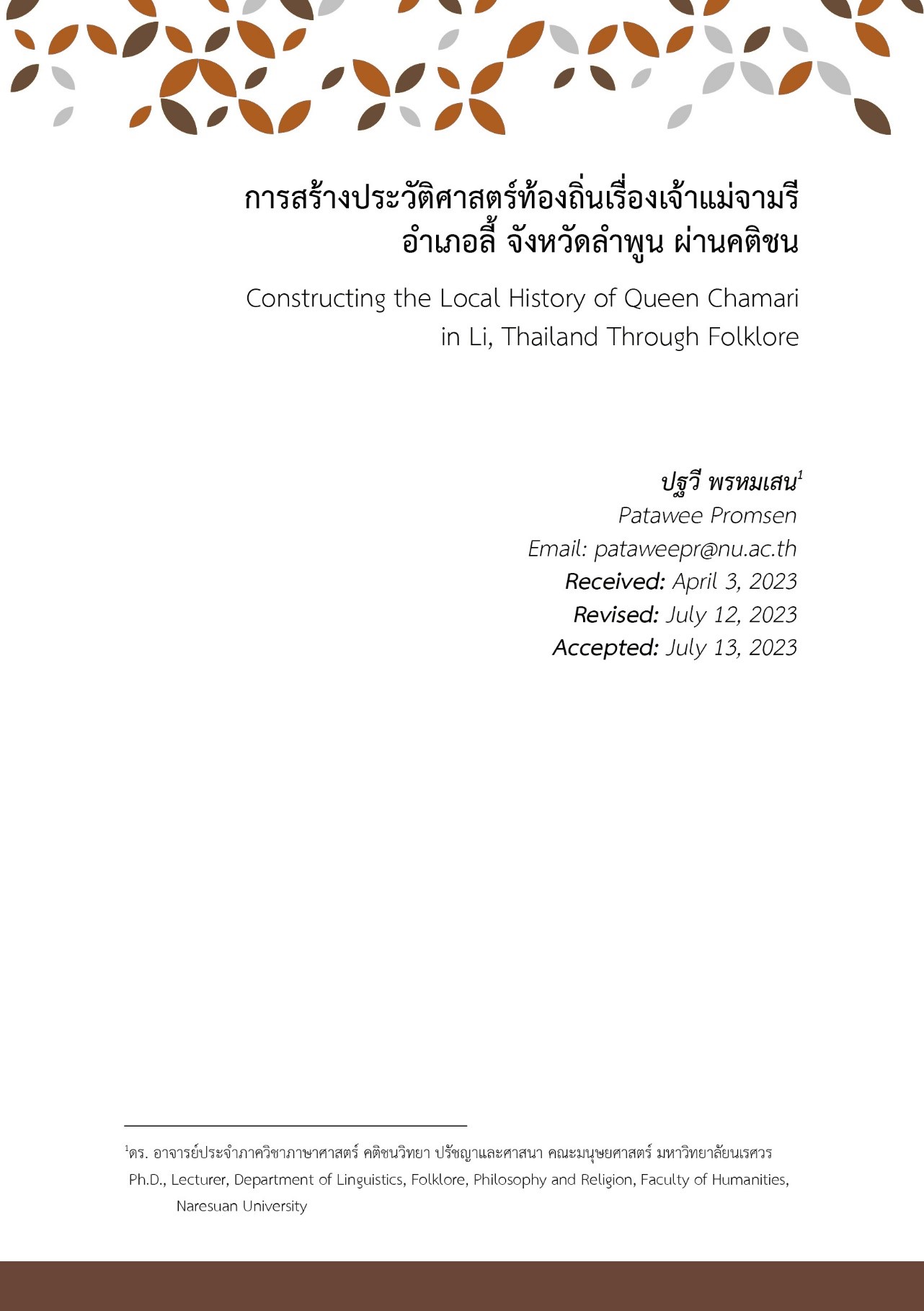Constructing the Local History of Queen Chamari in Li, Thailand through Folklore การสร้างประวัติศาสตร์ท้องถิ่นเรื่องเจ้าแม่จามรี อำเภอลี้ จังหวัดลำพูน ผ่านคติชน
Main Article Content
Abstract
This article explores various ways in which the people of Li District, Lamphun Province, Thailand, use folklore as a tool to remember and commemorate the local history of Li and the local hero “Queen Chamari.” It applies the concepts of folk history and collective memory to understand various oral traditions performed in the Li community. The results show that folklore operates in both verbal, material, and customary forms of commemoration. Verbal forms include historical legends passed down from generation to generation, supernatural legends connect to both ancient and present time, and place names. The material folklore includes mural paintings at Phrathat Duang Diao Temple, statues of queen Chamari, and particular buildings and sites. For the customary folklore, there are annual worship rituals known as "buang-suang" that take place in various locations throughout town. Folk songs are another folklore genre that is widespread in the local community. All these expressive cultures contribute to the reconstruction of Chamari and the town's history, which is gradually fading from the perceptions of both the young and people from other places, as Li has recently become well-known as the town of Three Khrubas, the revered monks of Lanna tradition. The folklore commemorations described here reflect the people of Li’s dedication to reenacting this forgotten history, and, more importantly, the forgotten identity of Li as a town ruled by a female queen.
Downloads
Article Details

This work is licensed under a Creative Commons Attribution-NonCommercial-NoDerivatives 4.0 International License.
References
Alver, B. (1989). Historical Legend and Historical Truth. In R. Kvideland, H.K. Sehmsdorf, & E. Simpson (Eds.),Nordic Folklore: Recent Studies (pp. 89–116). Bloomington: Indiana University Press.
Basso, K. H. (1996). Wisdom sits in places: Landscape and language among the Western Apache. Albuquerque: University of New Mexico Press.
Beiner, G. (2007). Remembering the year of the French: Irish folk history and social memory. Madison: University of Wisconsin Press.
Briggs, C. L., & Bauman, R. (1992). Genre, Intertextuality, and Social Power. Journal of Linguistic Anthropology, 2(2), 131–172.
Disch, H. A. (2012). A New Vision: Chamari, Chamadewi, and Female Sovereignty in Northern Thailand. Studies on Asia, 4(2), 1–60.
______. (2014). The Chronicle of Phra Nang Chamaridewi of Amphoe Li. The Journal of the Siam Society, 102, 119–142.
Dorson, R. M. (1972). Folklore and folklife: an introduction. Chicago: University of Chicago Press.
Dundes, A. (1999). International Folkloristics: Classic Contributions by the Founders of Folklore. Lanham: Rowman & Littlefield Publishers.
Fogelson, R. D. (1989). The Ethnohistory of Events and Nonevents. Ethnohistory, 36(2), 133–147. https://doi.org/10.2307/482275
Goldstein, D. E., Grider, S. A., & Thomas, J. B. (2007). Scientific Rationalism and Supernatural Experience Narratives. In Haunting Experiences (pp. 60–78). Denver: University Press of Colorado.
Nora, P. (1989). Between Memory and History: Les Lieux de Mémoire. Representations, 26, 7–24. https://doi.org/10.2307/2928520
Noyes, D., & Abrahams, R. D. (1999). From Calendar Custom to National Memory: European Commonplaces. In Cultural Memory and the Construction of Identity (pp. 77–98). Detroit, Michigan: Wayne State University Press.
Ongsakun, S. (2005). History of Lan Na. [2d ed.]. Chiang Mai, Thailand: Silkworm Books.
Samuel, R. (2012). Theatres of Memory: Past and Present in Contemporary Culture. London; New York: Verso Books.
Scott, J. C. (1985). Weapons of the Weak: Everyday Forms of Peasant Resistance. New Haven: Yale University Press.
Swearer, D. K., & Premchit, S. (1998). The Legend of Queen Cāma: Bodhiraṃsi's Cāmadevīvaṃsa, a Translation and Commentary. Albany: State University of New York Press.
Tanabe, S., & Keyes, C. F. (2002). Cultural Crisis and Social Memory: Modernity and Identity in Thailand and Laos. Honolulu: University of Hawai’i Press.


